

Welcome to Sal-Site. Monarch Watch : Migration & Tagging : Tagging Monarchs. Evolution MegaLab. Did you know that thanks to a common little snail you can find in your garden, in the park or under a hedge, you can see evolution in your own back yard?
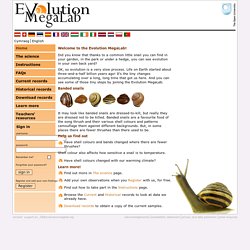
OK, so evolution is a very slow process. Life on Earth started about three-and-a-half billion years ago! It's the tiny changes accumulating over a long, long time that got us here. A model for natural selection – spaghetti worms. Class practical This involves placing baits of different colours (the ‘worms’) in a place where birds are known to search for food.
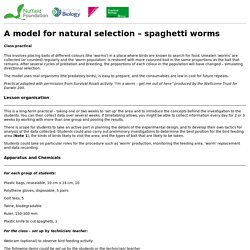
Uneaten ‘worms’ are collected (or counted) regularly and the ‘worm population’ is restored with more coloured bait in the same proportions as the bait that remains. After several cycles of predation and breeding, the proportions of each colour in the population will have changed – simulating directional selection. The model uses real organisms (the predatory birds), is easy to prepare, and the consumables are low in cost for future repeats. Practical adapted with permission from Survival Rivals activity “I’m a worm – get me out of here” produced by the Wellcome Trust for Darwin 200. Lesson organisation. School of Ants.
Zooniverse. Helping federal agencies accelerate innovation through public participation. Teaching Resources. A National Network of Field Classrooms - Hands on the Land. Climate Change Resource Center. Overview & Applicability i-Tree is a suite of several different applications that focus on the benefits of urban trees, however this page will focus on tools that specifically address the carbon and greenhouse gas emissions benefits of urban trees, including i-Tree Eco, i-Tree Streets, i-Tree Vue, i-Tree Canopy and i-Tree Design.
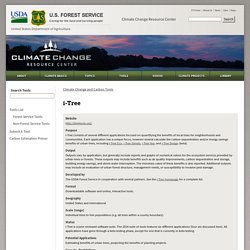
In general, each of these applications requires the user to define a study area, whether it be a residential home with a single tree or a larger area, such as a neighborhood, city or county, with a large population of trees. It then uses field inventory or sampling data (Eco, Streets, Design) and/or land cover data (Vue, Canopy) to calculate tree and forest structure and the benefits those trees provide. Communities can use existing tree inventories or can conduct a new project inventory depending on the application. Burst into Spring with Project BudBurst and PLT! Bird Biology. Click on the article title below to read.
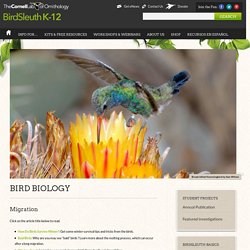
How Do Birds Survive Winter? : Get some winter survival tips and tricks from the birds.Bald Birds: Why are you may see “bald” birds ? Learn more about the molting process, which can occur after a long migration.Window Crash: Learn how you can help save birds from deadly window strikes.Birds Across Changing Seasons: No matter the season, give the content you’re teaching a “bird’s eye view.”American Robins: Signs of Spring?
: Find out how American Robins really spend the winter.Do Birds Sleep? Global Garlic Mustard Field Survey – www.garlicmustard.org. Using eBird with Students. eBird is a free and easy-to-use online data collection project that allows “regular” people to help scientists by sharing bird observations online.
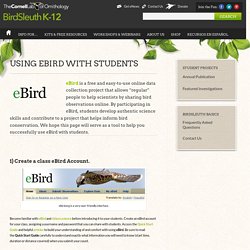
By participating in eBird, students develop authentic science skills and contribute to a project that helps inform bird conservation. CyberTracker GPS Field Data Collection System - Home. CyberTracker GPS Field Data Collection System - Home. Citizen Science. Examining new trends in citizen science. At the start of every year, most people will have made a list of New Year’s resolutions.
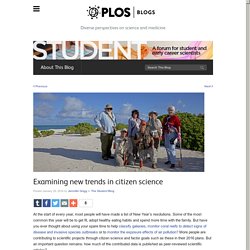
Some of the most common this year will be to get fit, adopt healthy eating habits and spend more time with the family. But have you ever thought about using your spare time to help classify galaxies, monitor coral reefs to detect signs of disease and invasive species outbreaks or to monitor the exposure effects of air pollution?
Global Invasive Species Database. The Global Invasive Species Database (GISD) aims to increase awareness about invasive alien species and to facilitate effective prevention and management activities.

It is managed by the Invasive Species Specialist Group (ISSG) of the SSC- Species Survival Commission of the IUCN -International Union for Conservation of Nature. The GISD was developed as part of the global initiative on invasive species led by the Global Invasive Species Programme GISP and was/is supported through partnerships with the National Biological Information Infrastructure (NBII), Manaaki Whenua-Landcare Research and the University of Auckland. The GISD focuses on invasive alien species that threaten native biodiversity and natural ecosystems and covers all taxonomic groups from micro-organisms to animals and plants in all ecosystems. eBird. Great Backyard Bird Count—take someone birding!
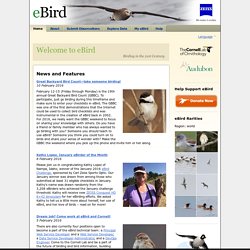
February 12-15 (Friday through Monday) is the 19th annual Great Backyard Bird Count (GBBC). To participate, just go birding during this timeframe and make sure to enter your checklists in eBird. The GBBC was one of the first demonstrations that the Internet could be used to collect bird checklists and was instrumental in the creation of eBird back in 2002. For 2016, we really want the GBBC weekend to focus on sharing your knowledge with others. Non Profit Environmental Organizations. Citizen Science. Education & Outreach Materials. Project Coyote. Citizen Science. Geocaching > Cache In Trash Out. Cache In Trash Out® is an ongoing environmental initiative supported by the worldwide geocaching community.
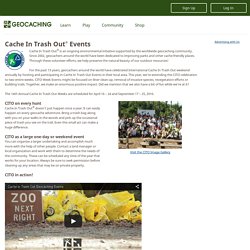
Since 2002, geocachers around the world have been dedicated to improving parks and other cache-friendly places. Through these volunteer efforts, we help preserve the natural beauty of our outdoor resources! For the past 13 years, geocachers around the world have celebrated International Cache In Trash Out weekend annually by hosting and participating in Cache In Trash Out Events in their local area. This year, we're extending the CITO celebration to two entire weeks.
CITO Week Events might be focused on litter clean-up, removal of invasive species, revegetation efforts or building trails. The 14th Annual Cache In Trash Out Weeks are scheduled for April 16 – 24 and September 17 – 25, 2016. Gmail – La messagerie avec espace de stockage gratuit de Google.
iConservePA. Home/land owners.
TreeVitalize - Home. Please Login for this Restricted Resource. Monarch Teacher Network. The Monarch Teacher Network (MTN) is a growing network of teachers and other people who use monarch butterflies to teach a variety of concepts and skills, including our growing connection with other nations and the need to be responsible stewards of the environment. Index. The Great Nature Project. PennsylvaniaCoordinator2. PBB_co2plants. JEI is a scientific journal for middle and high school scientists. Environmental Education. Education. Citizen Science Academy. FieldScope. Grade 9-12 Activity Descriptions. Below you will find some example classroom activities relevant to the 9-12 grade levels. Click on the icon to view standards associated with that activity. Do you have activities related to PBB that you have implemented in the classroom? Google Docs - create and edit documents online, for free.
Field Science Programs - Student Group Travel.